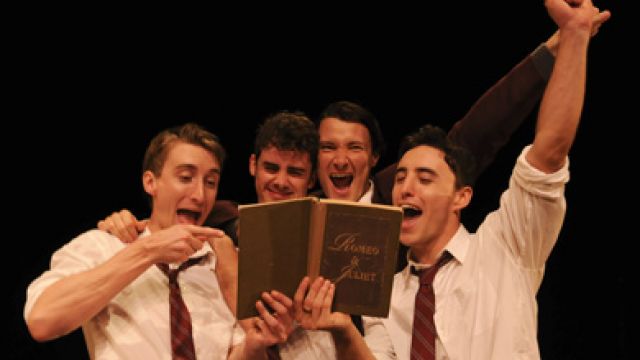Shakespeare’s R&J by Jo Calarco
Jo Calarco’s has set this adaptation in a Catholic Boy’s boarding school – where rules and repression mean the study of plays like Romeo and Juliet is banned. Four of the boys sneak out at night to read a copy of the play. Initial sniggering and suggestiveness fades as the emotion of the play takes over and opens them to their own emotions and sensuality. The script introduces the boys and their regimented school routine through snippets of marching and rote learning – a quirk being their boring declension of the Latin verb ‘to love’; a sharp contrast to their moving depiction later of the deaths of the young lovers.
Craig Iliott’s direction is sensitive and innovative. Pace and timing are carefully balanced. From the very beginning, space and movement are integral, making it a very demanding play for Iliott’s young cast – Julian Curtis, Ben Gerrard, Garth Holcombe and Tom Stokes. The script in itself is demanding and the pace of their delivery fast, yet clear and strong. Add to this the demands of relatively complex choreography, fight scenes, comic interaction, moments of quite sensitive emotion and many changes of character. Yet they seem unphased, each contributing strong personal and ensemble performances.
The design team have has followed Iliott’s innovation. Nick Dare’s set is simple – the school shield, four chairs, a trunk, a red cloth and a copy of Romeo and Juliet. This allows full use of the stage for movement sequences. A lasting image is the boys sitting on three of the chairs miming stitching the red cloth as they played Juliet, her mother and a very funny nurse!
Sam Chester’s choreography is creative, especially in the ball scene, where the chairs are the dancers! Matthew Marshall’s lighting makes a comparatively bare stage come to life, especially with the use of side lighting effects in specific scenes.
For those who love Shakespeare, this is a different take on a classic play – but it does work.
Carol Wimmer
Subscribe to our E-Newsletter, buy our latest print edition or find a Performing Arts book at Book Nook.

